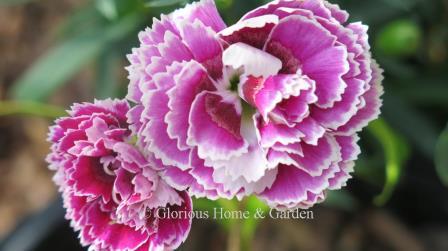- Home
- The Autumn Garden
- Vines for Fall
Choose Vines for Fall for Vertical Interest, Food for Wildlife, and Some Gorgeous Fall Color
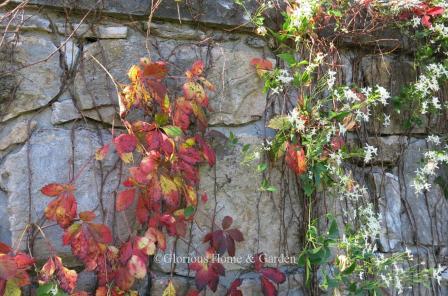 Parthenocissus quinquifolia and Clematis terniflora
Parthenocissus quinquifolia and Clematis ternifloraAdd vertical interest to the fall garden with vines that shine at this season. Some have attractive berries that are wonderful to use for Halloween or Thanksgiving decorations, and also provide good for birds and other wildlife. Some have leaves that turn vibrant colors of red or orange that look spectacular on a fence or brick or stone wall. And some even have late season flowers. That said, all of these vines can be aggressive and rampant growers if allowed free rein, and many of those berries can be liberally seeded by birds making them difficult to control or eradicate.
Ampelopsis brevipedunculata, porcelain vine, Zones 4 to 8. I list this here mainly as a warning. Yes, the berries are fascinating as they change to beautiful colors of purple, blue and turquoise as they mature. The first time you see one growing in the wild you may think, “Wow, wouldn’t that be beautiful on a fence or trellis?” But beware, this grape relative is fast-growing, a Japanese beetle attractant, and is invasive in many parts of the country. The berries may be cool, but the cons outweigh the pros for this vine.
Celastrus scandens, American bittersweet, Zones 3 to 8. American bittersweet is a marvelous North American native woody vine for fall that is extensively used for decorations. Highly ornamental, the yellow berries split open to reveal bright orange seeds. Best used in a naturalized area where its aggressive nature will not overpower more delicate plants, but can be used on a fence or trellis if controlled by pruning. Beware of planting the non-native Celastrus orbibulatus, the Chinese bittersweet, which has become an invasive weed in the Northeast.
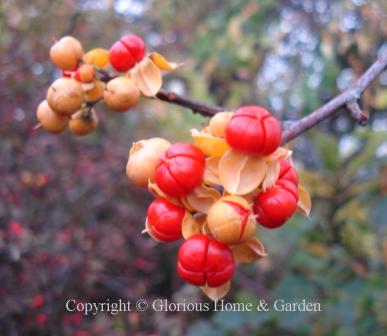 Celastrus scandens
Celastrus scandensClematis terniflora, sweet autumn clematis, Zones 4-9. Also known as C. paniculata, sweet autumn clematis signals the turning of the seasons when it blooms in late August into September and October. Beautiful in bloom, the fragrant white flowers completely smother the plant making a showy display. It is an aggressive grower and can reach 10 to 20 feet making it useful to cover unsightly stumps, weedy areas, even small buildings. Kept in check by pruning, it is an attractive vine for trellises, arbors and fences. Also, pruning after flowering before allowing to go to seed is another good control.
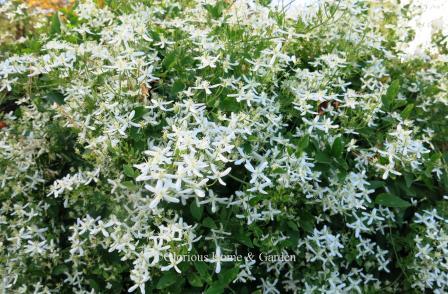 Clematis terniflora
Clematis ternifloraParthenocissus quinquefolia, Virginia creeper, Zones 3-9. Virginia creeper is a common North American native woodland vine. It is known for turning brilliant shades of purple to scarlet in autumn. Sometimes mistaken for poison ivy, Virginia creeper has five distinct leaflets distinguishing it from the three of poison ivy. It is a fast grower, often reaching up to 10’ in one season, to which I can attest to having pulled yards of it out of my woods only to have it return in no time. It makes an effective climber given a sturdy wall, fence, arbor or trellis, and needs no additional support given the “holdfasts” that occur at the ends of the tendrils. It can even be grown as a bonsai specimen. ‘Monham,’ also called ‘Star Showers,’ below is an attractive ornamental form that adds pink touches to the white and green variegation in cool weather.
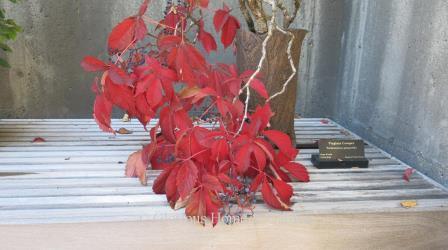 Parthenocissus quinquifolia grown as a bonsai at the North Carolina Arboretum.
Parthenocissus quinquifolia grown as a bonsai at the North Carolina Arboretum.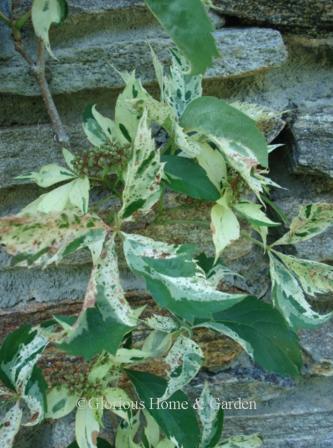 Parthenocissus quinquefolia 'Monham'
Parthenocissus quinquefolia 'Monham'Parthenocissus tricuspidata, Boston ivy, Zones 4-9. Boston ivy is perhaps the most famous vine for fall that is commonly seen on buildings (including famously on New England college campuses leading to the term “Ivy League,” though the vine is not technically an ivy), that turns brilliant shades of orange, red and purple in the fall. Avoid planting on wood or shingle siding as the “holdfasts” will be difficult to remove and can damage the wood or paint.
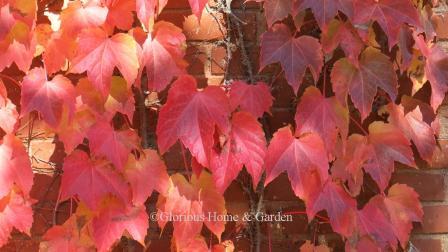 Parthenocissus tricuspidata
Parthenocissus tricuspidataVitis vinifera ‘Purpurea,’ ornamental grape vine, Zones 4-9. ‘Purpurea’ is a cultivar of the common grape that is very showy vine to grow on a sturdy arbor, trellis, or wall. The leaves in summer are purple and change to crimson in the fall. Clusters of edible grapes add to the ornamental character.
